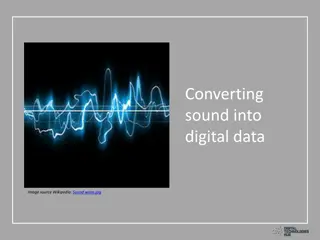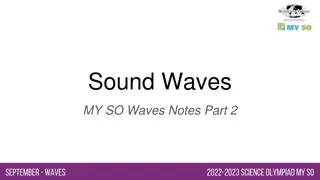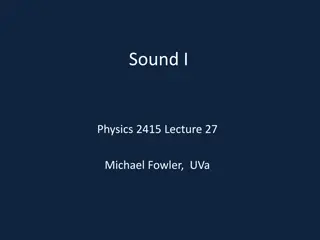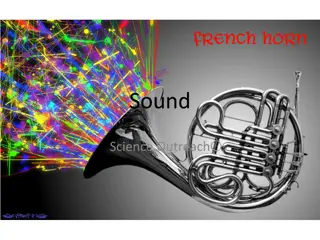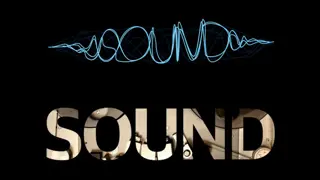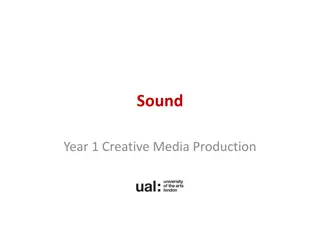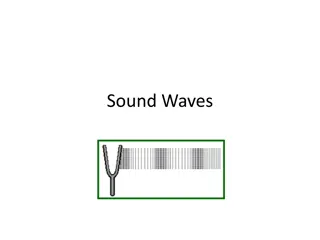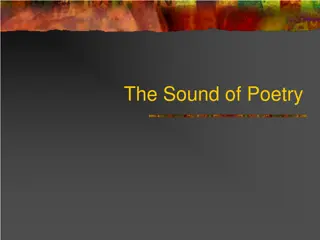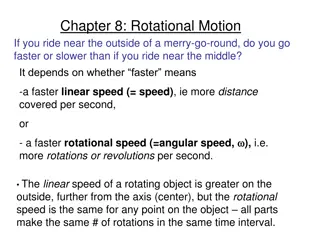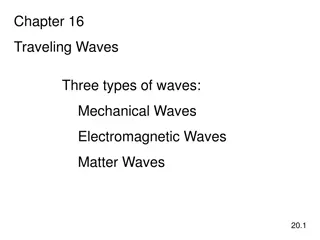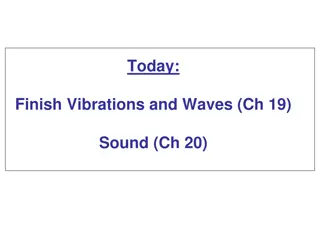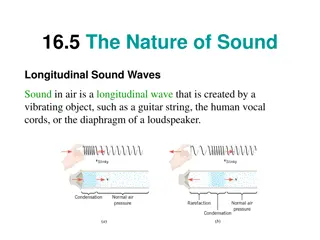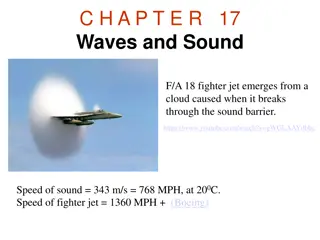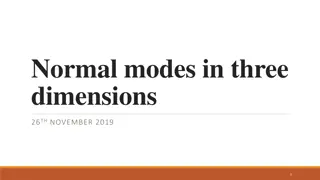Understanding the Speed of Sound and Wave Behaviors
Exploring the factors influencing the speed of sound and how it varies in different mediums, along with general wave behaviors such as interference, reflection, refraction, and diffraction. Examples and calculations provided to understand the principles better.
Download Presentation

Please find below an Image/Link to download the presentation.
The content on the website is provided AS IS for your information and personal use only. It may not be sold, licensed, or shared on other websites without obtaining consent from the author. Download presentation by click this link. If you encounter any issues during the download, it is possible that the publisher has removed the file from their server.
E N D
Presentation Transcript
Speed of Sound In general, the speed of sound is: Speed in solids>speed in liquids>speed in gases Speed of sound in air: v = 331 {(1+ T/273)}1/2where T is in Celsius Example: At a temperature of 100 degrees Celsius the speed of sound in air is 387 m/s.
Velocity of sound in air Not on test just FYI
What affects speed? The warmer the air, the faster the molecules are moving, the faster the sound travels. The more humid the air, the less dense it is, the faster the sound travels. (Lower mass = lower inertia = easier to move.) Sound moves fastest in Hydrogen.
Speed of Sound in a Solid: Y = Young s Modulus B = Bulk Modulus Both are stretching forces
Example 1: The bulk modulus of elasticity of air is 1.41x105 N/m2 and its mass density is 1.29kg/m3. Calculate the speed of sound waves in air. Solution: Using the formula v = (B / )0.5, we get: v = [1.41x105 / 1.29] m/s = 331 m/s. (Speed of sound in air at STP)
Example 2: The bulk modulus of elasticity of water is 2.1x109 N/m2 and its mass density is 1000 kg/m3. Calculate the speed of sound waves in water. Solution: Using the formula v = (B / )0.5, we get: v = [2.1x109 / 1000]0.5 m/s = 1400 m/s.
General Wave Behaviors Interference: When two waves occupy the same space at the same time. This can t happen with physical objects, but since waves are energy being transported this can occur. Reflection: When a wave bounces off a boundary. The energy returns in the same direction from which it came. For Optics Refraction: When a waves changes speed (and often direction) when it enters a new medium. Diffraction: The bending of a wave around a boundary. Also used mostly in optics.
Constructive and Destructive Interference: When two or more waves are occupying the same space, one must use superpostion to determine the new effect. You add together algebraically the heights of the waves. Constructive is when the waves interfere and the displacements have the same orientation. Destructive is when the waves interfere and have opposite orientation.
Fixed end reflection vs. Free End Reflection: Dan Russell
Three Ways Humans Can Physically Distinguish Sounds: Frequency Interpreted by the brain as pitch Intensity Interpreted by the brain as loudness Note: intensity is a physical measurement of any wave but loudness is the interpretation of the brain. Volume does not go up in a linear way. Harmonic content - Interpreted by the brain as timbre (layering of frequencies)
Human Hearing SS 8:29
Dilution of Sound on the Inverse Square How does Energy relate to Amplitude? At a distance R the amplitude is A, but at a distance 2R the A is 4 times greater, an at 3R the amplitude is 9 times greater. The energy gets spread such E is proportional to A2. How does energy relate to linear density? E is proportional to 1/(m/L) How does the Intensity relate to radius? I is proportional to 1/R2 Why? Because as you move away from R to 2R you have to spread that energy from Area at R out over 4 times the area.
How do you Calculate Intensity? Intensity is the Energy per time traveling through a particular area. Energy takes time to travel. If you wait twice as long, then twice as much energy goes through that area, but this doesn t double the intensity, just means more energy. So we want the rate at which energy goes through, or changes with time. That quantity is called what?? Power !
Formula: Intensity = Power/Area =E/(t x Area) Units? W/m2 Sound doesn t travel in circles like water waves, it travels in spheres, so the area is 4 r2 The further away you go, the quieter it gets.
Range of Intensity: Sound has a cool range. I for pain/bleeding from ears = 10 W/m2 But the faintest sound is defined as Io and Io equals 1 x 10-12 W/m2 This number is not fundamental by any means. At this intensity, the molecules vibrate at less than 1 width per molecule. I where stuff starts to break inside your ear is 1000W/m2
Notice! The range is not 1 to 5 but 10-12 to 10 W!! 10,000,000,000,000 - 1013 power! (Almost a quadtrillion - One thousand million million, 1015) That a huge range that we can hear. Too big .
So we made up a measurement of Intensity Level called Bells
Intensity Level, , measured in dB. = (10dB) log (I/I0) I = Io10( /10) The factor of 10 multiplying the logarithm makes it decibels instead of Bels, and is included because about 1 decibel is the just noticeable difference (JND) in sound intensity for the normal human ear. If the new intensity level increases by 10 dB, the new sound seems approximately twice as loud as the original sound.
Decibels provide a relative measure of sound intensity. The unit is based on powers of 10 to give a manageable range of numbers to encompass the wide range of the human hearing response, from the standard threshold of hearing at 1000 Hz to the threshold of pain at some ten trillion times that intensity.
Another consideration which prompts the use of powers of 10 for sound measurement is the rule of thumb for loudness: it takes about 10 times the intensity to sound twice as loud.
Table of Thresholds of Hearing Hearing threshold 0 dB 1 x 10-12 W/m2 Leaves fluttering 10-20 dB 1 x 10-11 W/m2 Whisper in an ear 30 dB 1 x 10-10 W/m2 Normal speech conversation 65 dB 3.2 x 10-6 W/m2 Cars/vehicles for a close observer 80dB 1 x 10-4 W/m2 Car without muffler 100 dB 1 x 10-2 W/m2 Live rock concert 120 dB 1 W/m2 Airplane taking-off for close observer 120 dB Pain threshold 130 dB 10 W/m2
Rules for Logs Log Rules: 1) logb(mn) = logb(m) + logb(n) 2) logb(m/n) = logb(m) logb(n) 3) logb(mn) = n logb(m)
Doppler Effect f = f {( v vo)/(v vs)} Numerator - if observer moves away from the source Denominator if source moves toward V = speed of sound Vs = speed of the source Vo = speed of the observer http://www.kettering.edu/~drussell/Demos/doppler/doppler.html
Quiz Review Anatomy of a wave Speed of a wave Compare and contrast types of waves: on a string, pressure, sound, EM Superposition Intensity Intensity level in dB Doppler





